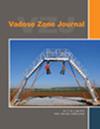Fate of herbicides in cropped lysimeters: 2. Leaching of four maize herbicides considering different processes
IF 2.8
3区 地球科学
Q3 ENVIRONMENTAL SCIENCES
引用次数: 2
Abstract
This study investigates the contamination potential of herbicides to groundwater with the help of numerical modeling (HYDRUS‐1D) and stable carbon isotopes for characterizing biodegradation. Four herbicides, metolachlor, terbuthylazine, prosulfuron, and nicosulfuron, were applied over a period of 4.5 years on two lysimeters located in Wielenbach, Germany, and monitored by lysimeter drainage. These lysimeters contained soil cores dominated by sandy gravel (Ly1) and clayey sandy silt (Ly2) and were both cropped with maize (Zea mays). In the preceding study, we characterized flow within the lysimeters by using stable water isotopes and unsaturated flow models. Building up on these findings, models were extended for describing reactive transport of the herbicides and investigating process contributions. At the end of the experiment, 0.9%–15.9% of the applied herbicides (up to 20.9% if including metabolites) were recovered by lysimeter drainage. Metabolite formation and accumulation was observed, and biodegradation was also indicated by small changes in carbon isotope signals (δ13C) between applied and leached herbicides. Model setups could describe the dynamics of herbicide concentrations in lysimeter drainage well. Concentration peaks in drainage were partly also linked with strong precipitation events, indicating preferential flow influence. The soil core with the coarser texture (Ly1) showed less herbicide leaching than the finer texture (Ly2), which can be explained by a larger mobile phase in Ly1. Overall, our approaches and findings contribute to the understanding of multi‐process herbicide transport in the vadose zone and leaching potentials to groundwater, where δ13C can provide valuable hints for microbial degradation.除草剂在作物溶渗仪中的命运:2。四种玉米除草剂不同浸出过程的研究
本研究借助数值模拟(HYDRUS‐1D)和稳定碳同位素来表征生物降解,研究除草剂对地下水的污染潜力。四种除草剂,甲草胺、特丁嗪、原磺隆和烟嘧磺隆,在位于德国维伦巴赫的两台蒸渗仪上使用了4.5年,并通过蒸渗仪排水进行监测。这些蒸渗仪包含以砂砾(Ly1)和粘质砂质粉土(Ly2)为主的岩芯,并且都种植了玉米(玉米)。在之前的研究中,我们通过使用稳定的水同位素和不饱和流动模型来表征蒸渗计内的流动。在这些发现的基础上,模型被扩展用于描述除草剂的反应性转运和调查过程贡献。在实验结束时,0.9%–15.9%的施用除草剂(如果包括代谢物,则高达20.9%)通过溶解计排水回收。观察到代谢产物的形成和积累,施用和浸出除草剂之间碳同位素信号(δ13C)的微小变化也表明了生物降解。模型设置可以描述溶渗计排水井中除草剂浓度的动态。排水中的浓度峰值也部分与强降水事件有关,表明优先流量影响。质地较粗的岩芯(Ly1)比质地较细的岩芯(Ly2)表现出较少的除草剂浸出,这可以通过Ly1中较大的流动相来解释。总的来说,我们的方法和发现有助于理解包气带中的多过程除草剂迁移和向地下水的浸出潜力,其中δ13C可以为微生物降解提供有价值的提示。
本文章由计算机程序翻译,如有差异,请以英文原文为准。
求助全文
约1分钟内获得全文
求助全文
来源期刊

Vadose Zone Journal
环境科学-环境科学
CiteScore
5.60
自引率
7.10%
发文量
61
审稿时长
3.8 months
期刊介绍:
Vadose Zone Journal is a unique publication outlet for interdisciplinary research and assessment of the vadose zone, the portion of the Critical Zone that comprises the Earth’s critical living surface down to groundwater. It is a peer-reviewed, international journal publishing reviews, original research, and special sections across a wide range of disciplines. Vadose Zone Journal reports fundamental and applied research from disciplinary and multidisciplinary investigations, including assessment and policy analyses, of the mostly unsaturated zone between the soil surface and the groundwater table. The goal is to disseminate information to facilitate science-based decision-making and sustainable management of the vadose zone. Examples of topic areas suitable for VZJ are variably saturated fluid flow, heat and solute transport in granular and fractured media, flow processes in the capillary fringe at or near the water table, water table management, regional and global climate change impacts on the vadose zone, carbon sequestration, design and performance of waste disposal facilities, long-term stewardship of contaminated sites in the vadose zone, biogeochemical transformation processes, microbial processes in shallow and deep formations, bioremediation, and the fate and transport of radionuclides, inorganic and organic chemicals, colloids, viruses, and microorganisms. Articles in VZJ also address yet-to-be-resolved issues, such as how to quantify heterogeneity of subsurface processes and properties, and how to couple physical, chemical, and biological processes across a range of spatial scales from the molecular to the global.
 求助内容:
求助内容: 应助结果提醒方式:
应助结果提醒方式:


